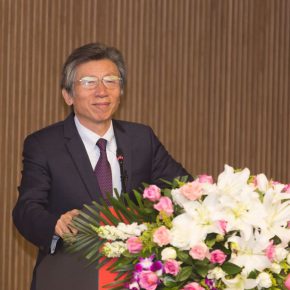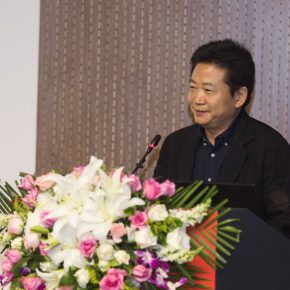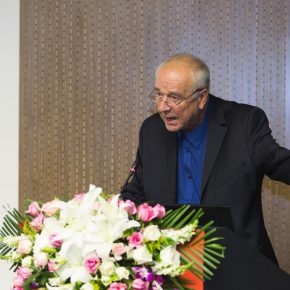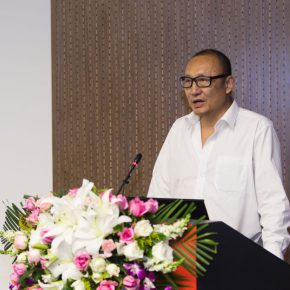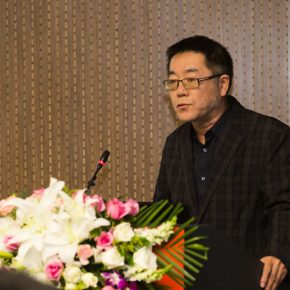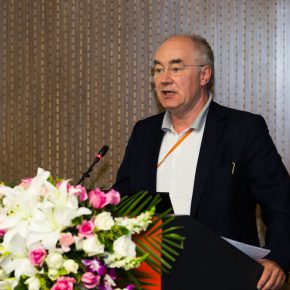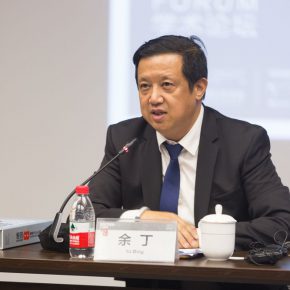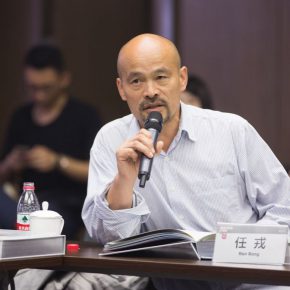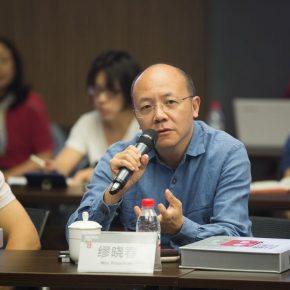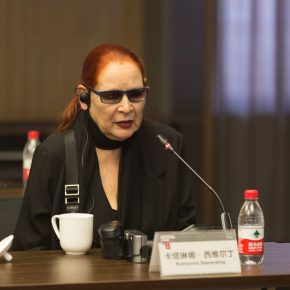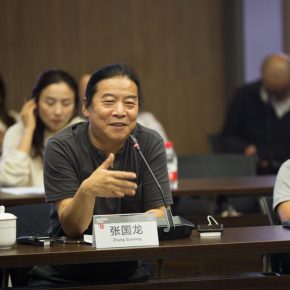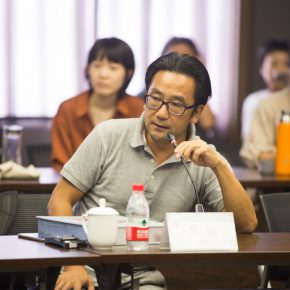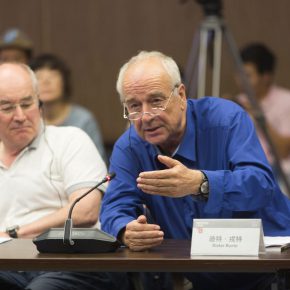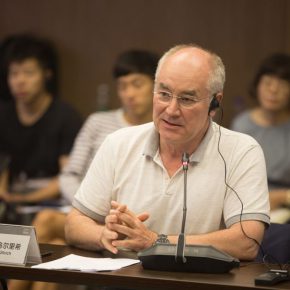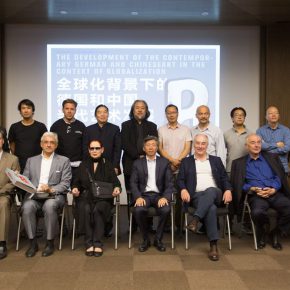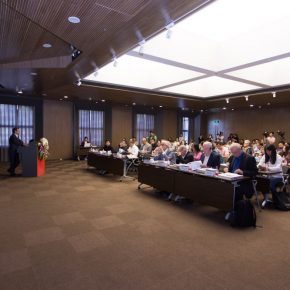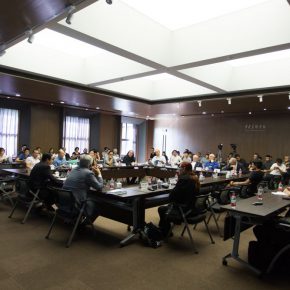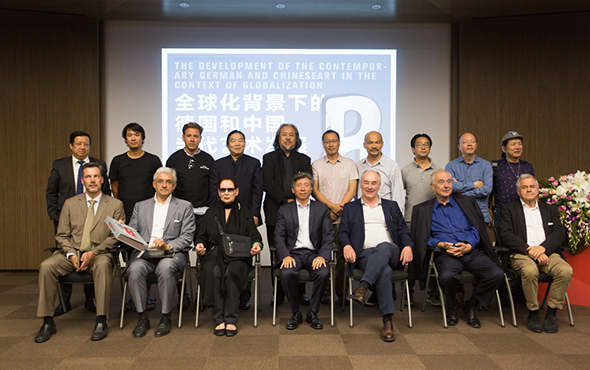
On September 18, 2017, the academic forum entitled “Development of Contemporary German and Chinese Art in the Context of Globalization”, as an important academic event in the framework of “Deutschland 8”, was held at CAFA. It was composed of keynote speeches and a round-table discussion, that researched the development context and characteristics of German and Chinese art since the second half of the 20th century, and communicated & summarized the issues such as art education and communication between the two countries. It invited honored guests including both scholars and curators who have been involved in long-term research on German and Chinese contemporary art, as well as Chinese artists who have lived, studied and created in Germany. Their respective practical results do not only help people to further discern the cultural coordinates and development direction of contemporary art of the two countries, it also reflects the value of the exchanges and dialogues between different cultures under the global cultural conditions from one side.
Keynote Speech: “Art’s Integration and Construction in a Global Context”The morning forum was entitled “Art’s Integration and Construction in a Global Context”, which was hosted by Zhang Zikang, Director of CAFA Art Museum. First of all, Fan Di’an, President of Central Academy of Fine Arts and a general curator for “Deutschland 8” delivered a speech entitled “Art’s Integration and Construction in a Global Context”, this offered a profound discussion on the interrelations and cultural characteristics of Chinese and German art, and put forward that the ontological construction and integrating dialogue of the art from different countries in the global context was an urgent subject.
In his speech, President Fan also mentioned that “Deutschland 8” was held due to the results of favorable climatic, geographical and human conditions. Therefore, it was very important for China and Germany to join hands to engage in a cultural dialogue, especially using the exchange of ideas to embody a new relationship between countries, which elevated the cultural dialogue between China and other countries to a new level. For the post-war German art’s trends and characteristics, Fan summarized it in two aspects: Firstly, it is a“sense of history”, and the second one is “performance”. There are two features of German art that really make the circles of Chinese art, intellectual and thought, as well as the public that have a spiritual resonance. The analysis of German art is actually a reflection of Chinese art. Chinese art should have an integration and dialogue with international art and traditional art based on the ontology-building, reflecting the cultural responsibility and ability of the two countries in a global situation.
Peter Iden, Art Critic and former Director of Museum for Modern Art Frankfurt then started a conversation on “Informal Art”. Prof. Peter Iden introduced the development of abstract art and informal-art in Germany, and deeply analyzed the deep ideas and contributions of German informal art. In his view, there were two decisive steps that determined the development of abstract art: firstly, artists including Kandinsky, Mondrian, and Malevich, who began the abstract wave around the world; secondly, through the reflection and liquidation of the historical process, Germany further developed the abstract art after the end of WWII, and the artist rejected the mass culture, rejected the commonplace mass, because they believed that it was these mass movements that have destroyed the country; thirdly, the artists, through the reflection of the self, were able to express the spontaneity of this abstract art.
Xu Jiang, President of the China Academy of Art gave a speech on “Deutsche’s Spirit and Our Body Signs”. President Xu started from the experience of studying aboard in Germany to talk about German cultural spirit’s influence on the students aboard. There are mainly three factors: the way of “Deutsche’s thinking and absorbing” which motivates him to inquire into history and to unfold his creation based on the present; “Deutsche’s professional duties and loyalty” have influenced his way of working; and “German intellectuals’ tribute to Sinology and Orientalism” triggered his thoughts on Chinese traditions.
Dieter Ronte, Former Director of Art Museum Hannover, Art Museum Vienna, Art Museum Bonn was the fourth person to deliver a speech, and he talked about the differences of the concept and idea between Chinese and German art, which were divided into 5 points: Firstly, Chinese art mainly applied the themes related to people’s lives; secondly, China did not exclude imitation, while Germany paid more attention to the original; now more new media art could be seen in China; fourthly, globalization led to the convergence and entertainment of art, so it was necessary to emphasize the sustainability of the work; fifthly he hoped that the artwas not dominantly influenced by the economic value system.
LaoZhu, President of International Association of Art History, CIHA and Professor of Peking University introduced the overall state of Chinese contemporary art. Prof. Zhu divided contemporary Chinese art into three categories: firstly, it was an art type where the artists criticized the social system and real problems, which were accepted and familiar with Germany and even other western countries. Secondly, the contemporary art forms which were related to traditional Chinese art, such as the artist Xu Bing’s work; thirdly, it referred to those new artistic ways of using new technology and new media to explore the future of humans, which had nothing to do with the West or China. Prof. LaoZhu put forward his own view – perhaps the artists would not be divided by the country any more in future, but they were separated by group, because they had a common sense, and also bore a common responsibility for the future.
Walter Smerling, Chairman of the Stiftung für Kunst und Kultur e.V, Director of Museum Kueppersmuehle Duisburg and a general curator for “Deutschland 8” delivered a speech and took the “Art in Public Space” as a clue to talk about the mode of operating and managing of art, with the ultimate goal of presenting art, and allowing art to be recognized and accepted. He hoped through the cultural confrontations, cultural contests and cultural discussions to make more modern works that could be presented in public spaces. Rooted in the “Deutschland 8”, it would continue to launch enlightening activities.
Wang Huangsheng, Professor of CAFA, Deputy Director of National Art Museum Committee and former Director of CAFA Art Museum delivered a speech on “Cutting-Edge Experiments and Historical Reflection in Chinese Contemporary Art”. Prof. Wang started from the third CAFAM Biennale and “Exploring the History of Chinese Contemporary Images and Red Images” held by the Berlin National Photography Museum in Germany, for an experimental exploration of the cutting-edge issues of the artists and art institutions, as well as questioning historical issues.
In the end, Prof. Ferdinand Ullrich from Münster Art Academy, and former Director of Kunsthalle Recklinghausen delivered a speech. Different from Prof. Peter Iden who researched the context of informal-art in Germany, Prof. Ferdinand Ullrich introduced the reason why informal-art, and the artistic explorations of part of the major informal artist groups appeared in the Ruhr area.
Round-table Discussion: Contemporary Art and Contemporary Art Education in Germany and ChinaThe afternoon round-table discussion was themed “Contemporary Art and Contemporary Art Education in Germany and China”. Moderator Yu Ding introduced the participants of the discussion: Zhang Guolong, Ma Lu, Miao Xiaochun, Liu Yonggang, Li Di and Ren Rong, who have studied and created in the German Academy of Fine Arts; Uwe Kowski, Andreas Mühe, Katharina Sieverding, Michael Sailstorfer, Sebastian Riemer, and four German honored guests who delivered a speech in the morning. The general curator Walter Smerling gave an opening statement.
After the artists Ren Rong, Miao Xiaochun, Zhang Guolong, Katharina Sieverding, Peter Iden and Walter Smerling delivered a speech, Yu Ding said that, it focused on the training of skills and the artistic view of the unity of heaven and man in China, when the Chinese artists were cultivated. “Do one’s utmost in the subtle detail and apply oneself to the mass” is the motto of CAFA, which was from Confucius, “Do one’s utmost in the subtle detail” referred to starting from the observation to the proficiency of skill; “apply oneself to the mass” referred to a state, character and style of a person. Based on which, Yu Ding questioned whether it was an inevitable relationship between an artist and an academy or not? Artists Andreas Mühe, Li Di, Dieter Ronte, Katharina Sieverding, Sebastian Riemer, Ferdinand Ullrich, Liu Yonggang and Zhang Guolong respectively expressed their ideas. German artists generally believed that the purpose of the art school was to have speculative discussions with the students, and there were many ways for a person to become an artist, apart from going to an academy, while the majority of Chinese artists believed that the academy of fine arts was very important to the growth of artists.
After the tea break, Yu Ding summarised the previous discussion, and said that, the role of the academy of fine arts had changed, on the one hand it maintained traditional basic skills, and on the other hand, it was an irradiator and leader of thought, while also playing the role of a critic. And he questioned what was highlighted in the relationship between art education and contemporary art in Germany? Ferdinand Ullrich answered that there was no absolute or effective so-called correct basic method of teaching, or any idea of technical teaching, while the more important thing was the mission – to become a very interesting artist. Peter Iden then questioned what CAFA could offer students? Ma Lu then introduced the academy, galleries, collectors and networks offering students a variety of opportunities. Yu Ding added that CAFA and the majority of Chinese academies of fine arts applied the teaching system and standard of the European academies of fine arts.
Walter Smerling asked a question about the market, what possibility did it have for the formation of an art market? Yu Ding, as Dean of the Institute of Arts Administration and Education, CAFA, answered the question with the data, the young artists entered galleries where there was forever a market demand. A variety of Chinese institutions offered a commercial platform for young artists, but only the top and lucky ones could be picked out. Katharina Sieverding hoped to maintain the autonomy of art, rather than being influenced and raped by the so-called marketization, integrating the attitude of the artist, the involvement of new media, and the impact of market factors, as well as exchanges with other countries into the teaching. Miao Xiaochun took Chen Man and Chi Peng as examples, to affirm the positive role of the market. Walter Smerling pointed out that students who did not satisfy the needs of the market were not promising.
Finally, President Fan Di’an gave a conclusion to the forum, that “Deutschland 8” has aroused a very wide range of impact, and the academic forum has opened a topic for both sides. All these things are new beginning for a Sino-German artistic exchange.
Text by He Yisha, Wu Huixia, Wu Jing, translated by Chen Peihua and edited by Sue/CAFA ART INFO
Photo by Hu Sichen/CAFA ART INFO


